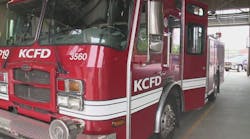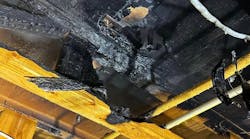Answer: U.S. Fire Administrator Dave Paulison is providing significant guidance in his leadership in a vast number of areas to strengthen the focus and direction of the agency. His appointment of Marko Bourne as his executive officer has provided the agency with a public affairs professional who has a clear understanding of the significance of marketing as a tool for public and emergency services.
USFA is a part of the Federal Emergency Management Agency (FEMA) within the Department of Homeland Security. In addition to being executive officer of the USFA, Bourne currently serves as the acting deputy director for preparedness in FEMA. As FEMA executive officer, he is responsible for policy development and all USFA external communications to the public, the media, Congress and other federal agencies. He is also a principal advisor to the U.S. fire administrator and deputy administrator and served on the transition team that created the Department of Homeland Security (DHS).
Bourne was appointed in 1997 by Governor Tom Ridge as the press secretary for the Pennsylvania Emergency Management Agency. He also was the founding executive director of the Pennsylvania Fire and Emergency Services Institute, which he served for over six years. Bourne has over 18 years of disaster, fire and emergency services experience and holds bachelor's and master's degrees in fire science and public administration. He was the FEMA spokesperson at the Pentagon during the first days following the 9/11 terrorist attack and he was in charge of the FEMA Joint Information Center in New York following the World Trade Center attack.
Recently, I interviewed Bourne about the role of marketing within the U.S. Fire Administration.
Firehouse: In general, we would like to demonstrate how USFA uses marketing management to further the mission and vision of the agency to achieve its goals nationally. Can you give a quick overview?
Bourne: Marketing is a critical tool for any agency or organization that expects to influence public behavior. Unfortunately for many years, USFA has not had a concerted marketing focus of its mission and its programs. Some of that has been a budgetary issue and some has been structural to its placement within FEMA. In the past two years, USFA has undertaken a much broader approach to marketing that is already showing extensive benefits to the agency, the public and to the first responders community we serve.
Firehouse: How does USFA define marketing?
Bourne: Well, the dictionary defines marketing as "the business activity of presenting products or services to potential customers in such a way as to make them eager to buy." At USFA we view it in a larger context of not just wanting the public to "buy" our fire safety message, but as a broader effort to prepare our communities for fires and all hazards.
Prevention and mitigation of fires and other hazards will do far more to make America a safer place to live and raise a family. As a result our marketing efforts are aimed at community outreach, direct public appeal, preparation of firefighters and first responders, training emergency officials and being the national advocate for all hazard prevention.
Firehouse: How much value does it place on the discipline?
Bourne: We place an enormous value on marketing. Simply and most basely put, our budget, our existence and our most important success in reducing loss of life is wholly dependent on our ability to market our products to the public, Congress, the administration. In order to achieve those goals we need to make sure that when people think of fire prevention and preparedness, they think of the United States Fire Administration. When emergency and fire officials think about the premier training and education system for senior fire services leaders, we want them to first think of USFA's National Fire Academy and our state partners.
Firehouse: Is marketing part of the strategic plan?
Bourne: Marketing is very much part of the strategic plan. As part of the Blue Ribbon Commission Report that helped to transform USFA, marketing and outreach was one of the largest set of recommendations and was widely viewed by the commission members and the USFA staff as critical to the future success of the Fire Administration.
Firehouse: How does USFA's national marketing penetrate and make itself felt locally?
Bourne: One of the keys to the success of any marketing strategy is how your organization gets its message to the local level. For USFA the key has been to focus on understanding who our audience is. Who are we trying to reach? What message are we trying to send? What is the most effective way to send that message? How do we measure the results? It is an ongoing process that must include a good understanding of the best ways to meet your audience. Media such as TV and radio, newspapers, flyers, training programs, conferences and the web are all ways to reach audiences, but you need to focus your effort to penetrate the local level with the method that they will be likely to see or hear.
USFA has concentrated its efforts to several high-risk audiences. We set five strategic goals in three categories, which we live by, budget for, measure against and set timeframes to achieve results that are ambitious but not necessarily unreachable.
The USFA Five-Year Operational Objectives are:
- Reduce the loss of life from fire by 15%.
By reducing by 25% the loss of life of the age group 14 years old and below, and
By reducing by 25% the loss of life of the age group 65 years old and above, and
By reducing by 25% the loss of life of firefighters. - 2,500 communities will have a comprehensive multi-hazard risk reduction plan led by or including the local fire service, and
- To appropriately respond in a timely manner to emergent issues.
To achieve those goals we focused on specific marketing products - video, radio, fact sheets and outreach efforts - to address those audiences. As an example, we have launched an aggressive media monitoring program that reviews the media for fires from across the nation and when one is identified involving an injury or loss of life and fire safety fact sheet is sent directly to the media in that community to take advantage of the "teachable moment."
Firehouse: What are the key initiatives USFA wants to achieve from a marketing perspective?
Bourne: Our strategic goals I mentioned above are our key initiatives. Every effort we have in place is oriented to helping achieve those goals.
There is still a "fire problem":
Challenge 1 - There is still a "fire problem." We continue to unnecessarily lose too many people to fire related deaths across this nation. We lost 3,000 people on Sept. 11, 2001; however, we continue to lose more people than this, each year, to fire. Most of these deaths are under the age of 14 and over the age of 65.
Challenge 2 - Firefighter deaths and injuries. Too many firefighters are dying in the performance of their duties. In 2002, 102 men and women lost their lives in service to their communities. The most disturbing part is the majority of those deaths were due to heart attacks and traffic accidents. Everyone in the fire service today can make that number go down.
Challenge 3 - The need to achieve interoperability among departments. We need to recognize and work together to address equipment interoperability. A firefighter can leave a fire station and travel less than a mile to assist another fire department, and nothing works. Breathing apparatus, rescue equipment and hose couplings are just a sample of equipment failing to achieve interoperability.
You and I know that we need each other in the fire community. There is no fire department in this great nation that is capable of handling, by themselves, an act of terrorism or a massive disaster. There is also no firefighter that can guarantee to the American public, that all of the equipment arriving on location will be compatible. The individuality of fire service equipment has cost us lives. Our inaction to achieve interoperability will hurt our ability to address the challenges of these times. The time has arrived to provide solutions to this problem together.
Challenge 4 - Lack of consistent communications systems among local agencies. Communications problems have long plagued us, and as result of the creation of the patchwork of communication systems (800 mhz, UHF, VHF) many American fire departments currently are unable talk to other fire departments. They often cannot communicate with law enforcement and other governmental agencies responding to unified command emergencies. Together we must find solutions to our numerous and potentially harmful communication problems-and solve the issue of interoperability.
Challenge 5 - Differences in incident command systems. While there has been significant acceptance of incident command principles by the fire service, there remain differences from community to community. In this country there are differences in the incident command systems the fire services respond with, and many other adaptations and nuances you have created locally. Imagine for a moment, an emergency to which all of the fire service personnel in several jurisdictions were called. What incident command system would you use? Acts of terrorism or massive natural disasters that strike your hometown allow no time to debate a sector vs. a group. The time has arrived, to set aside our differences and accept one common incident command system for all fire departments and first responders. An incident command system which provides a common understanding and acceptance of law enforcement, emergency management, public works, utilities, medical professionals, federal and state responders and citizens to work safely under a system common to all incident responders.
Challenge 6 - Nationwide credentialing needed. The lack of a commonly accepted incident command system leads to another significant all-hazards homeland security problem. There currently is no nationwide credentialing system similar to the American forest service "Red Card" program. The lack of a credentialing system creates problems when hundreds of firefighters, police and EMS personnel self-dispatch themselves into an emergency. It further creates a lack of mutual aid protocols, scene control and the lack of interstate and intrastate mutual aid agreements.
Challenge 7 - Volunteer and career firefighters. I would like to step back for a moment and address a sincere concern of the administration, which I share. America's firefighters have for far too long created a national culture of distinguishing between volunteer and career firefighters - not to celebrate our heritage, but to divide our service. We view this as a potential weakness for the American fire service. Rather than defining and solving community hazards and addressing current challenges together, far too many service decisions are being made based on whether you are volunteer or career, and thereby wasting valuable time, energy and resources.
Firehouse: What are the marketing mechanisms now in place to further those initiatives? What is the structure of the "marketing department"?
Bourne: USFA, now as part of the Preparedness Division of FEMA, is in the process of reorienting into a more formal marketing process. Preparedness will have a marketing and outreach team, which will coordinate efforts with the USFA public information officer and with a liaison from the FEMA Office of Public Affairs. This staff will work with the USFA program staff to develop outreach and marketing campaigns, work with USFA contracted marketing and PR firms, the national fire and emergency services organizations, and allied groups to implement the marketing strategies.
Firehouse: What is the role of advertising and public affairs?
Bourne: Advertising plays an important role, but is not the only method we utilize. I also am not as big a fan of the public service announcement route normally taken by government agencies. Seeing a public service announcement at 3 A.M. does not get the message to those that need to hear it. The Ginsu infomercial would win every time.
I am a firm believer in targeted ads that are bought for specific time periods and aimed at specific audiences. TV, radio, billboards are all part of that effort. But we also have found that sending fire safety information directly to newspapers and local media immediately following a fire with loss of life or injury is far more effective in communicating our fire safety message and is even free.
Firehouse: What are the USFA's target markets, its various relationship groups? Stakeholders? How are you building coalitions?
Bourne: Currently, our target markets are the age group 14 years old and below, the age group 65 years old and above, and firefighters. Our stakeholders include hundreds or fire and emergency services organizations, industry, state and local governments, other federal agencies and the media.
Firehouse: How is USFA's marketing role translated into support for the fire and emergency medical services?
Bourne: In the past two years, aggressive USFA marketing of the Assistance to Firefighters Grant Program and the Needs Assessment for the Fire Services that we conducted with NFPA (National Fire Protection Association) have had a positive impact on the services and has brought results. There is a heightened awareness of the needs of the fire services and the role states and local government plays in providing supportive funding. Sept. 11, of course, had arguably the greatest impact on public opinion and it is our job to work with the fire and EMS services to translate that into long term support.
Firehouse: Is there a marketing role for USFA in support of the Department of Homeland Security?
Bourne: We have a significant responsibility to support the department and the national homeland security effort. As the national focus for fire department related issues and a significant role in fire department based EMS operations, we assist the department as a whole in understanding and responding to a large segment of the first responder community. Our marketing responsibility specifically lies with informing the nations fire departments about what resources and information is available to them to help build our homeland security.
Firehouse: What is USFA's role at the community level? Specifically, what has been the success of the civilian volunteer initiatives recently implemented?
Bourne: Fire departments, of course, have the most significant role at the community level. Our role is to provide national level resources to help them in their efforts, not to supplant their efforts. The Citizen Corps initiative of President Bush is a striking example of a way to harness the vast potential of American citizens to undertake efforts to protect their communities and to respond to tragedy when it strikes. We are honored to be a significant part of that effort with the Community Emergency Response Team (CERT) Program. This program developed by the Los Angeles Fire Department almost 20 years ago and adopted by FEMA in 1993 is the best way to harness that civilian volunteer energy and provide concrete training and organization to help people get ready for emergencies and to respond to them. We are working closely to tie these efforts to local fire departments and other emergency management and emergency responders to form a corps of folks who can help fire departments out when tragedy hits.
Firehouse: What measurement system, if any, does USFA use to measure its marketing success?
Bourne: We are looking to develop several measurement systems to assess our success. We ultimately will use NFIRS (National Fire Incident Reporting System) to see if we are having an impact of fire loss. We will also be looking at measuring how the Assistance to Firefighters Grant Program is impacting the overall preparedness of our fire departments. This will be done through studies, surveys, empirical data where available and market research.
Firehouse: What kind of resources, in terms of dollars and people, does USFA have to create and implement marketing strategies?
Bourne: We currently have one person on staff dedicated solely to marketing USFA programs. However, as part of FEMA's Preparedness Division, we are building additional marketing support with two additional staff people and we also are leveraging our marketing support with the FEMA and DHS Offices of Public Affairs. This is a quantum leap ahead of where we were just a few short years ago. Our marketing funds are not budgeted separately, but are developed out of program dollars to promote awareness campaigns. We are looking in future years to be able to develop specific marketing budgets that can be allocated as needed to address the overall marketing strategy.
Firehouse: Can you give some examples of those recent programs, which can show some results and measurements?
Bourne: We are very proud of many of our outreach programs, especially the ones that address senior citizens and children. Fire death and injury rates have declined in the past few years and we are looking now to see if our programs have had an impact.
Last year, we unveiled a new campaign to re-energize the use and maintenance of smoke detectors through what we called the "Tribute to Heroes Campaign." This PSA (public service announcement) campaign for print, TV and radio focused on the new public appreciation of the fire services and highlighted the need for the public to "protect those who protect you" by installing and maintaining a smoke detector. The key point is have a working smoke detector so you and your family can get out of a burning building, so the firefighters don't have to additionally risk their lives to get you out. This PSA has had thousands of airings across the nation last year.
Firehouse: Please list possible programs you would like to create and implement if you could.
Bourne: The list is almost endless, but to narrow it to one, we are looking to develop a national strategy to promote the use of automatic fire suppression sprinklers in all occupancies to include single- and two-family homes. Even systems just in kitchens can have a dramatic impact on fire loss. We are working with the International Association of Fire Chiefs, UL (Underwriters Laboratories) and others to develop this initiative.
Firehouse: How would you see marketing "perfection" for USFA?
Bourne: I honestly don't believe perfection is possible and we will always be looking to improve our message and our strategies. The ultimate goal would be to have no fires involving loss of life or property. We can never achieve the "no fires" part, but USFA is firmly committed to the idea that we can, working with partners across the nation, achieve or come darn close to the "no loss of life" goal in the next 20 years.
Firehouse: Does the National Fire Academy have a comprehensive marketing curriculum for executive fire officers?
Bourne: Marketing is embedded in several of our programs for executive fire officers. We do not need to develop Marketing 101 programs, but instead create public safety higher-level programs that look to strategy and management levels. How to build a marketing program in the face of tough budget times and how to show marketing success through analysis of local fire losses are critical elements of the Executive Development course. It is also a part of the Fire Prevention curriculum.
Firehouse: On behalf of Firehouse® I would like to thank you for the time and thought that you contributed to this interview.
Ben May has over 15 years of experience creating and applying the discipline of marketing management to fire departments and emergency service organizations. He has been a firefighter and fire commissioner, and is a graduate of the Montgomery County, MD, Public Service Training Academy. May has over 25 years of experience in business-to-business marketing and sales in the U.S. and internationally. Currently, his responsibilities include developing new business at Walt Disney World's Epcot. May was fire commissioner in Woodinville, WA, from 1994 to 1998. He graduated Phi Beta Kappa from the University of Oklahoma with a bachelor of arts degree in public affairs and received his master of arts degree in international communication from the American University. May is a member of the Society of Executive Fire Officers, a trustee of the Education Foundation of the Florida Fire Chiefs Association and a board member of the Tampa Firefighter's Museum. He welcomes your feedback on the column and he may be contacted at [email protected].







